>> Back to The HooK front page
COVER- Stream of consciousness: UVA gives Meadow Creek second chance
Published August 14, 2003 in issue #0232 of The Hook

By KATIE HAMLIN
They're coming out. They're diversifying and multiplying.
They're beginning to sing a little more about seeing the light and wail a little less about paradises being paved.
The benthic macroinvertebrates of Meadow Creek have been laying low and dying out from high levels of pollution that curb the creek's ability to support various types of critters, including crayfish and dragonflies. Their reduced numbers suggest that the creek's ecosystem is headed down the tube.
Where did all the little guys go?
For over 50 years the once thriving creek has been funneled underground throughout the majority of its run through UVA, from Observatory Hill to its outlet near University Hall. At one time, the Grounds harbored several streams and ponds that were gradually destroyed over time. [For more, see the sidebar on the history of one special pond.]
"It was a wet, wet place, this university," says historian Coy Barefoot.
As the school expanded, Barefoot says, it drained its ponds and forced the creek into a series of gigantic pipes, known as culverts, to make way for the construction of more buildings and roads.
The result in 2003? A dirty creek with fecal coliform levels that have put it (along six other Albemarle waterways) on Virginia's Department of Environmental Quality's list of the state's "impaired" waters. Ewww!
It's not just little critters that suffer. As the culverts struggle to accommodate heavy rains, lowland areas, like the intersection of Emmet Street and Ivy Road flood, causing havoc for human pedestrians and drivers.
Perhaps fittingly, UVA, the very institution that first sent the creek underground, is in the process of giving the creek and its critters a new lease on life. The University's move to "daylight" or bring back above ground-- Meadow Creek is receiving accolades even from those who don't call the creek home.
"Daylighting is certainly not common," says Robert Cooper of the State Department of Recreation and Conservation, who was responsible for approving the arena's stormwater plan. "It takes some stretching of the imagination to satisfy regulations in such a new and innovative way."
UVA landscape architect Mary Hughes expects "a huge visual change" in the Dell area across from Memorial Gym. Once the site of the home of UVA prof and grounds superintendant William Lambeth, the Dell has in recent years served as a boggy site for a bronze sculpture of two fighting deer.
The Dell will soon become the site of a stream channel and detention pond meant for the waters of Meadow Creek to run through. It is here, just south of Alumni Hall, that a 1,200-foot section of the creek is slated to see the light in the spring of next year as a part of UVA's storm water management plan for the new basketball arena.
The arena?
It might be over half a mile north of the Dell, but the arena site at Copeley Road is where the creek leaves University property and, depending on rainfall levels, it usually leaves pretty darn fast.
By the time it's traveled underground almost all the way through UVA, the water can also be pretty darn dirty.
In hopes of cleaning up the creek, addressing flooding issues, and managing the arena's stormwater, UVA looked to the alternative approach of using daylighting at two sites for part of the answer. Upstream, Meadow Creek will be daylighted at the Dell. Farther down the creek's watershed, a tributary of the creek is being moved at the new parking garage on Ivy Road. The dual projects, combined with extensive underground stormwater pipes at the arena, make up UVA's great hope in facing its stormwater woes with a "regional approach," in which several sites are incorporated into a single plan.
But there are woes.
Like many commuters who find themselves in the occasional wading pool at the Emmet and Ivy intersection, a central low point in the watershed, Hughes has seen first-hand the effects of forcing large amounts of water into a culvert.
Hughes remembers a manhole cover was shot up in the air, unable to hold back the creek's pressure. On any given afternoon after a hard rain, cars roll slowly through murky water collecting at the corner, with no worry of hydroplaning; it's more likely that one will need to caulk up his station wagon to float by the tennis courts.
In the past, like most large institutions, UVA has installed stormwater management mechanisms piece-meal, one project at a time. Culverts are largely utilized as a means to transport surface runoff and water from creeks and streams away from a given development. The upside is that buildings can go up, and roads can be paved on top of a creek rushing through a pipe.
The downside, however, is more insidious than it initially appeared. In 1996, UVA officials began realizing that this traditional way of managing their water was not only costly because of the numerous developments that were projected, but was also a severe detriment to the Meadow Creek watershed. When UVA began reviewing and adjusting its master plan in the mid-'90s, it looked to the expertise of three firms: Cahill Associates of West Chester, Pennsylvania, MMM Design Group of Norfolk, and Philadelphia-based Andropogon Associates to study the possibilities for managing the school's water resources.
The master plan outlines the University's acceptance of its responsibility for the creek's decimation, as well as its commitment to stripping the creek of its "ignominious distinction of having the worst water quality within the Rivanna watershed" at its outlet point from the University.
The initial recommendations materialized into the full-fledged endeavor the three-part project is today. But while that initial master plan got the wheels turning, it wasn't until plans for the new basketball arena a $130 million project to replace U-Hall-- got under way that work on the daylighting of Meadow Creek really accelerated.
Whenever a new development is proposed, planners need a seal of approval from the Virginia Department of Conservation and Recreation, showing that the project takes into account how it will handle stormwater .
The master plan set out an ambitious alternative to manage stormwater, but the Meadow Creek project needed to be able to dip into the arena's large budget in order to begin the daylighting. Work on the waterways at the Dell and the garage site was partially absorbed under the umbrella of the arena project, led by VMDO Architects, once UVA hooked on to the regional approach that required all three sites working together as one organ.
"The project is happening right now," says Kennon Williams, of Nelson-Byrd Landscape Architects firm, "because the arena is happening right now."
Controlling water through daylighting farther up the watershed at the Dell, as well as at the new parking garage, is actually more important to the arena's stormwater plan then anything that can be done directly at the arena site.
UVA's project director, Dick Laurance, estimates that the cost of the Dell alone will reach seven figures, but a large part of that cost will be covered by the arena's budget.
During the construction of the parking garage on Ivy Road, an ailing stream located on the back of the property line was relocated and restored in a newly built channel. It sends the water underneath a fieldstone-veneered bridge, which assists the university's attempts to make the area an idyllic setting in which to park your car or perhaps have a picnic.
The water flows about 700 feet before it heads back underground to cross Emmet Street where it joins Meadow Creek. From there the creek enjoys a little light before meandering back across Emmet Street headed towards the arena site where it gushes out again near Copeley Road.
Both the Dell and parking garage sites will go a long way in offsetting the ugly appearance of parts of a campus blanketed constantly in orange construction safety tape.
Biohabitats Inc., an environmental consulting firm that designed the project's streams, and Nelson-Byrd Landscape Architects, the creators of the Dell's original schematic design, teamed up to develop the Dell as a full-fledged ecosystem. Leaning in the urban design tradition of linear parks based on corridors of flowing water like the famous "emerald necklace" parks in Boston, the Dell will be a feast for plant lovers and for Wahoos seeking some respite from exam stress.
Besides the beauty of a thriving creek, Dell dwellers will be able to also enjoy a small pond that will be the creek's resting point before it returns to pipe life in order to cross Emmet Street, surfacing again near Lambeth student housing to the north.
Williams emphasizes the Dell design's commitment to representing all the diverse native Virginia plant-life. The horticulture will largely be planted in three separate segments meant to correlate with three regions of Virginia; mountain, piedmont, and coastal areas.
Closer upstream, in the direction of Alderman Road, Williams projects a "mountain plant palette," complete with plants usually found in the state's upper elevations, namely green ash and hemlocks. Midstream, plantings might include those found in the Piedmont area, including Ironwood red maples and river birches. Towards the bottom of the Dell, coastal areas of Virginia could be represented by sweetbay magnolias and Virginia sweetspire.
While the open creek, the pond, and the plantings add to the overall beautification of the Dell, their real value to the creek lies in their healing properties.
Jeff Sitler, a UVA geohydrologist who handles the university's storm water compliance issues, praises the Dell project for enabling the creek to help itself through daylighting. "A stream in a pipeline is not much of an ecosystem," Sitler says. "By placing the creek back in its natural environment, processes take place that enable to creek to develop different plant life."
Sunlight maintains the plant life that feeds on the water's excess minerals. The water's microorganisms work to remove pollutants through chemical and biological processes. The pond aids in filtering out some of the water's impurities by slowing down the creek, thus allowing some sediment to drop within the pond instead of being carried downstream.
While UVA is eager to clean up Meadow Creek and its tributaries, being eco-friendly is also an efficient alternative to standard storm water management practices.
Engineers outfitted both the pond outlet at the Dell and the outlet of the creek's sister stream that runs in front of the new garage with special storm water control structures that will regulate the rate of the water leaving both sites to prevent flooding down at the arena site.
Storm water control structure may not sound too exciting, but it is actually a very recent advance in hydrotechnology, and working together, the structures link the respective sites they serve. Under normal conditions, Meadow Creek and its tributary will flow freely through both the Dell and the parking garage site. In the event of a downpour, which prior to daylighting would turn the Creek into a churning floodzone, the structure permits only a certain amount of water to leave, and forces water to back up temporarily into basin areas.
Steve Benz, an engineer with Judith-Nitsch Associates, worked to develop the storm water master plan and have it approved by Virginia's Department of Conservation and Recreation.
"This is a big step," says Benz, "in realizing some major improvements in water quality and regulation that effects all of Charlottesville, not just the school."
Benz says UVA's greener approach serves as a positive role model. Longwood University in Farmville is one school that is considering a plan like UVA's in the years to come. Other schools might jump on board after seeing the benefits of daylighting. The garage site has already been a site of study by students in the Architecture School, who have examined the careful design and relocation of a tributary there.
Professor Linda Blum, from the University's environmental science department, is hopeful about future opportunities at the various sites for data collection. While most of the labs in the department's introductory class are "hands-on", she regrets that the majority are merely demonstrations "that only simulate how field work is conducted."
While there are other instances of daylighting occurring around the country, many are within a strictly business setting, thus there is not a ready and committed research base in place to study the actual benefits of the alternative measure.
Hughes stresses the obvious opportunity for UVA as an institution of research, since "it plans to be here for 200 more years."
Hopefully some of the approach's ambiguities can be cleared up through such research. Cooper acknowledges the blind faith that the school must go on with such an unorthodox plan. "With a project like this, you can't really quantify in terms of pollutants removal; you just know that something good is being done."
From his experience, Cooper judges that the upfront investment will save UVA a lot of time and money in the future. "With 40-some odd projects that they will work on in the next few years," he says, "they certainly don't need to worry about doing everything on a site-by-site basis."
Daylighting, while hardly common, has occurred in several spots throughout the country as a way to preserve urban waterways from being completely destroyed. In some cases developers consider the innovative practice only to opt for a more traditional approach in the face of building costs and time restraints.
For instance, in northern Seattle, the Simon Property Group, owner of Charlottesville's own Fashion Square Mall, continues to battle with the city for a loosening of restrictions in its development of Northgate Mall. When the developer decided against daylighting, local environmentalists hindered the project by turning to that city in hopes of derailing the development they claimed was environmentally irresponsible.
Four years later, the development's struggles continue amid the resonating battle cries of its detractors, "Creeks or Concrete!"
Aware that some property owners elsewhere may be dragging their heels, many applaud UVA's resolution to spend a little more green to be a little greener.
"UVA is a great client to have," says Lee Mallonee of Biohabitats Inc. "Rarely do you get a client that lets you do things the way it should be done."
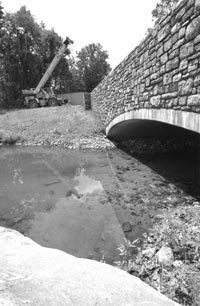
This tributary of Meadow Creek at the new parking deck already has been given a fancy new bridge.
MAP COURTESY UVA
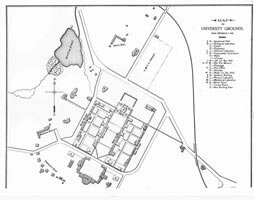
A creek runs through it: UVA covered up its pond as well as Meadow Creek.
MAP COURTESY UVA
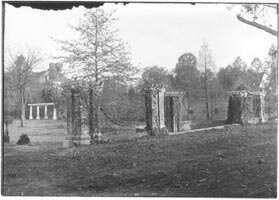
Then: The Dell as it looked circa 1920.
PHOTO COURTESY UVA
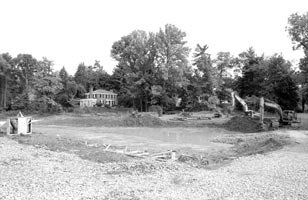
Now: It The Dell will soon be even wetter than before.
PHOTO BY JEN FARIELLO
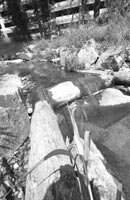
.The Creek's tributary along Ivy Road
PHOTO BY JEN FARIELLO

Stretching from the UVA cemetary on Alderman Road to Emmet Street between Alumni Hall and Education School, the Dell will soon offer an opportunity to see Meadow Creek and a new pond.
PHOTO BY JEN FARIELLO

Landscape Architect Kennon Williams
PHOTO BY JEN FARIELLO

Jack Richards at The Dell construction site inspects progress
PHOTO BY JEN FARIELLO
#
>> Back to The HooK front page
|